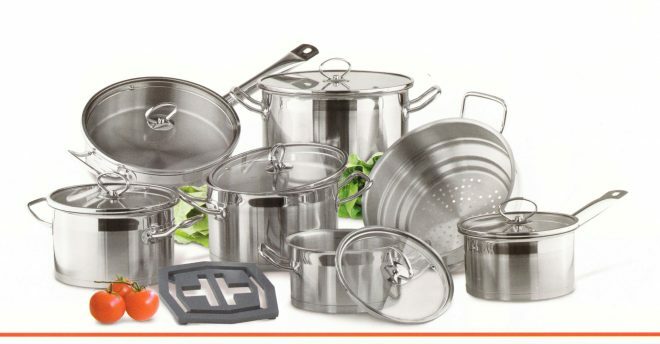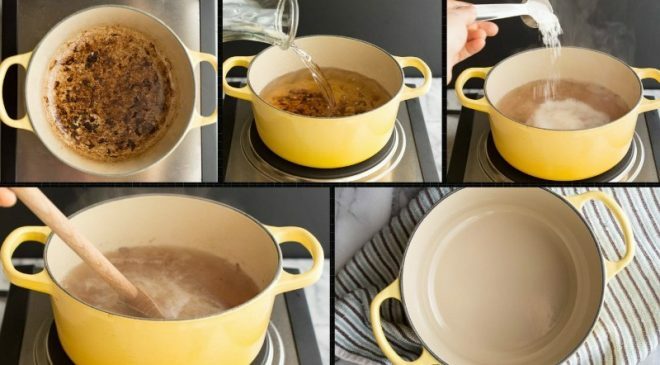The carbon deposits formed in the pan after cooking are best washed off immediately, before it has time to dry. But sometimes it happens that fresh plaque does not lend itself to cleaning with standard detergents. In addition, the choice of a method for removing contamination is also influenced by the material used to make the utensils.
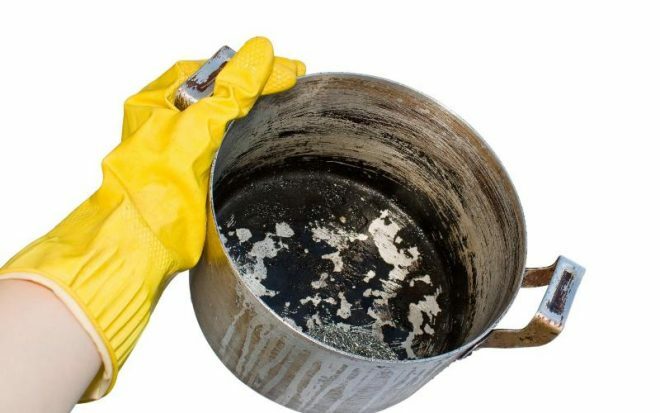
How to clean different types of dirt
The table shows products that are difficult to remove from the surface of pots and how to remove them.
Attention! Earned on our website kitchen designer. You can familiarize yourself with it and design your dream kitchen for free! May also come in handy wardrobes designer.
Product |
Removal method |
Milk |
Boiling |
Buckwheat |
Boiling |
Rice |
Soaking |
Sugar |
Boiling |
The methods are suitable for all materials from which the pans are made.
Cleaning enameled dishes
Enamel pans are primarily intended for preparing first courses. It is undesirable to boil milk and stew vegetables in such a bowl. All this will lead to the appearance of a stubborn layer of carbon deposits. In addition, it is strictly forbidden to use a metal brush on an enamelled surface. Therefore, layering should be removed by one of the following components:
- salt;
- soda;
- vinegar;
- activated carbon;
- laundry soap;
- milk whey;
- whiteness.
Soda or salt
Add 6-7 large tablespoons of salt or baking soda to a saucepan that has already poured 800-900 ml of water. And since in a large amount of liquid the powder will simply dissolve and will not give the desired result, the volume of water should vary within the specified limits.
The powder added to the water is thoroughly mixed, and the resulting solution remains in the container for 12 hours. During this time, the consistency is successfully absorbed into the formed plaque, which will facilitate its further removal.
After 12 hours, the pan is put on fire, and the liquid in it is brought to a boil, which should last at least half an hour. Then the cleaning agent is poured out and the dishes are rinsed thoroughly.
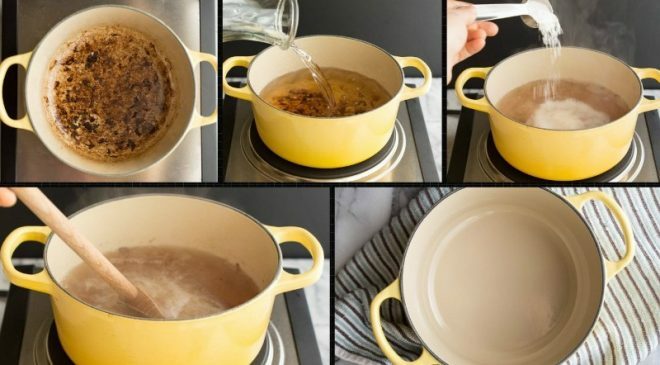
Vinegar
You can also wash the enamelled container with 9% vinegar. To do this, it is poured so that the plaque is completely closed. And those areas of carbon deposits that could not be covered are gently wiped with a cloth moistened with the same vinegar.
Four hours after the agent has been absorbed, the dishes are wiped with the hard side of the sponge, then the remaining dirt is washed off with water.
Since vinegar is quite caustic and can injure hands, all work is carried out with rubber gloves.
Activated carbon
The product is not the main cleaning agent, but its use complements other methods of cleaning, since often after the first time small deposits of carbon remain.
In this case, one teaspoon of water is added to the powder of 5-6 tablets. The resulting consistency is rubbed into the remaining areas of the plaque.
Within 30 minutes, the activated carbon solution is absorbed into the carbon deposit and then removed with a sponge. Then the container is thoroughly rinsed.
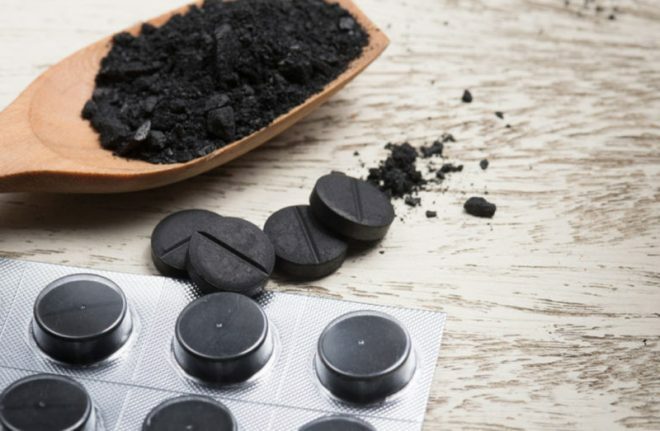
Laundry soap
Cleaning with laundry soap is an excellent complementary method and will also remove fresh deposits.
To prepare a soap solution, you need half a brick of laundry soap. And so that the bar quickly dissolves in water, it is passed through a vegetable grater.
Thoroughly mixed soap shavings are put on fire and brought to a boil, which lasts 30 minutes. The container is removed from the stove, and the soapy liquid is poured out. After the performed manipulations, the cooled pan is cleaned with dishwashing detergent, and the applied components are washed off with warm water.
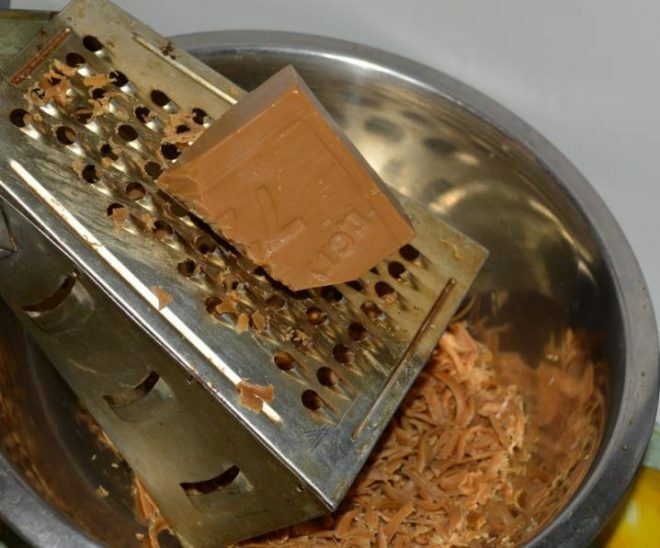
Milk serum
Lost milk should not be thrown away, as it is great for cleaning enamel cookware. For this, the bottom and sides of the pan are doused with milk whey. The container is in this state for 12 hours, after which the applied consistency, along with carbon deposits, is washed off with a detergent.
White
The main aspect when using a whitening product is safety. Since whiteness can harm exposed parts of the body, you should work with the product only with rubber gloves.
The cleaning process itself boils down to the fact that the bleaching liquid is diluted in water, and the resulting product affects the pollution within one hour.
But the amount of whiteness depends on its manufacturer. After all, the manufacture of these household chemicals can be carried out according to different templates. And in order not to spoil the dishes, during the first use of the product, you should familiarize yourself with its label. The amount of chemistry indicated on it should be halved during the first cleaning of the pan.
If household chemicals do not give the desired result, then the cleaning procedure must be repeated, while increasing the amount of bleaching agent.
If it was not possible to wash the container using the selected method, there are still undissolved carbon deposits in the dishes, then you should re-process the pan, but in a different way.
How to clean an aluminum pot
The advantage of aluminum pots is that the water boils in them much faster than in the same enamel cookware. However, aluminum is a rather soft metal and, scraping off the carbon layer from it with a metal brush, is easily damaged. Chips, invisible to the eye, are formed, which subsequently enter the food.
But there are ways that will not deform aluminum cookware. These include cleaning using:
- salt and soda;
- citric acid;
- sour fruits;
- silicate glue.
Salt and soda
A salt-soda mixture is obtained by mixing the components in a one-to-one ratio in a burnt pan. Water is added to the consistency in such an amount that a viscous thick is formed from the mixed powder. It should not turn out to be too liquid, otherwise the solution will not fully affect the burnt layer.
In this case, the carbon layer must be completely covered with the cleaning mixture. The solution in the utensils should be kept for 24 hours, after which the container is emptied and filled with water, which is boiled there for 30 minutes. The pan is then completely rinsed.
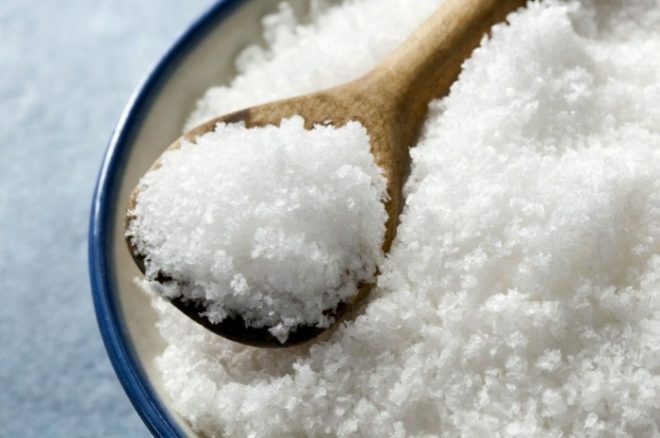
Lemon acid
Citric acid also effectively removes carbon deposits on aluminum coatings. To obtain a cleansing liquid, you will need 25 grams of citric acid per liter of water.
The resulting product is poured into burnt utensils and boiled there for an hour and a half. After which the mixture remains in the dish for another 40 minutes. After this time, the liquid is poured out, and the container is rinsed with clean water.
Instead of citric acid, you can use fresh lemon juice and sour apples.
In the case of using apples, one hour is given to absorb the juice. Then water is poured into the dishes, which is boiled there for an hour and a half, after which the container is thoroughly rinsed.
Silicate glue
Silicate glue is a type of office glue. But its positive qualities also show up well when cleaning aluminum cookware. To remove all burnt layers from the pan, 100 g of silicate glue and 100 g of soda are mixed in a contaminated container, after which water is poured there. Moreover, taking into account that there is a maximum amount of liquid in the container.
The resulting consistency is boiled for one hour and then poured out. And an empty pan, in turn, is thoroughly washed.
How to clean a stainless steel pot
Durability is what stainless steel cookware can demonstrate with proper care. Such pots do not have a protective coating that can break off from temperature changes. But the absence of an additional layer does not prevent stainless steel products from being in operation for a long time.
However, like utensils made of any other material, utensils made of steel do not tolerate cleaning with abrasive materials. But if soot does appear, then there are ways of washing that are possible with the help of improvised means. These methods include the use of:
- soda;
- coffee;
- vinegar;
- activated carbon;
- salt.
Before soaking the pan in soda solution, stainless steel dishes are pre-washed with a liquid detergent, and then wiped dry. Then the soda is poured into the utensils, and in such an amount that the bottom of the container is completely closed.
To obtain the desired solution, a little water is also added to the container. The solution should resemble a thick gruel. The resulting consistency is pounded throughout the container.
For the soda to be absorbed into the carbon deposit, you need to wait two hours. After this time, the container is rinsed.
The same algorithm of actions is performed in the case of using coffee, which is diluted with water to the state of a liquid gruel, and then pounded along the bottom and walls of the dishes.

And here is the absorption time activated carbon much less carbon deposits, although it is applied according to the same principle. It is 20 minutes.
For cleaning salt the pan is pre-filled with water, which is brought to a boil. And after that, 3 large tablespoons of salt are added to the bubbling liquid, which evaporates within 2 hours.
Problematic areas that have appeared in stainless steel utensils are also well removed 9% vinegar. To do this, the agent is dotted for 10-15 minutes on those places that need processing, after which the pan is rinsed clean.
How to clean ceramic dishes
If you do not know how to care for utensils made of ceramics, then you can completely ruin them. To prevent this from happening, you should completely abandon abrasive brushes and detergents containing acids when cleaning ceramic dishes.
To remove carbon deposits from ceramics, it is enough to pour ordinary water into the utensils and bring the liquid to a boil. In this state, the water will dissolve the resulting layers. After the bulk of the carbon deposits have peeled off, the remaining dirt can be easily removed with a damp sponge.
To enhance the effect, a gel detergent is added to the water. Just before that, you should make sure that it does not contain aggressive alkalis.
Also, to remove carbon deposits from ceramic dishes, alcohol is used, which is applied to a sponge and rubbed into the contaminated surface. Then the pan is thoroughly rinsed.
Although abrasives and metal brushes are good at removing carbon deposits, using them will deform the pan. Therefore, in order to remove carbon deposits, first of all, it is necessary to build on the material of manufacture of the container. Although the cleaning methods for enamel coatings, stainless steel and aluminum are similar, ceramics has limitations, since it does not tolerate aggressive acids found in some products for washing.
average rating 1 / 5. Number of ratings: 1
No ratings yet. Be the first to rate.
